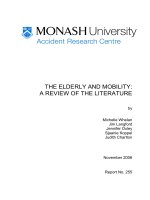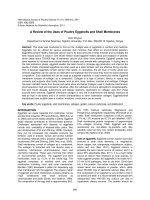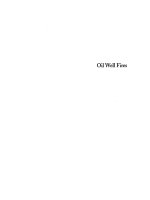Stress and Performance - A Review of the Literature and Its Applicability to the Military pdf
Bạn đang xem bản rút gọn của tài liệu. Xem và tải ngay bản đầy đủ của tài liệu tại đây (242.68 KB, 86 trang )
This document and trademark(s) contained herein are protected by law as indicated in a notice appearing
later in this work. This electronic representation of RAND intellectual property is provided for non-
commercial use only. Permission is required from RAND to reproduce, or reuse in another form, any
of our research documents for commercial use.
Limited Electronic Distribution Rights
This PDF document was made available from www.rand.org as a public
service of the RAND Corporation.
6
Jump down to document
THE ARTS
CHILD POLICY
CIVIL JUSTICE
EDUCATION
ENERGY AND ENVIRONMENT
HEALTH AND HEALTH CARE
INTERNATIONAL AFFAIRS
NATIONAL SECURITY
POPULATION AND AGING
PUBLIC SAFETY
SCIENCE AND TECHNOLOGY
SUBSTANCE ABUSE
TERRORISM AND
HOMELAND SECURITY
TRANSPORTATION AND
INFRASTRUCTURE
WORKFORCE AND WORKPLACE
The RAND Corporation is a nonprofit research
organization providing objective analysis and effective
solutions that address the challenges facing the public
and private sectors around the world.
Visit RAND at www.rand.org
Learn more about the RAND Corporation
View document details
For More Information
Purchase this document
Browse Books & Publications
Make a charitable contribution
Support RAND
This product is part of the RAND Corporation technical report series. Reports may
include research findings on a specific topic that is limited in scope; present discus-
sions of the methodology employed in research; provide literature reviews, survey
instruments, modeling exercises, guidelines for practitioners and research profes-
sionals, and supporting documentation; or deliver preliminary findings. All RAND
reports undergo rigorous peer review to ensure that they meet high standards for re-
search quality and objectivity.
Stress and Performance
A Review of the Literature and
Its Applicability to the Military
Jennifer Kavanagh
Approved for public release; distribution unlimited
The RAND Corporation is a nonprofit research organization providing objective analysis
and effective solutions that address the challenges facing the public and private sectors
around the world. RAND’s publications do not necessarily reflect the opinions of its
research clients and sponsors.
R
®
is a registered trademark.
© Copyright 2005 RAND Corporation
All rights reserved. No part of this book may be reproduced in any form by any electronic or
mechanical means (including photocopying, recording, or information storage and retrieval)
without permission in writing from RAND.
Published 2005 by the RAND Corporation
1776 Main Street, P.O. Box 2138, Santa Monica, CA 90407-2138
1200 South Hayes Street, Arlington, VA 22202-5050
201 North Craig Street, Suite 202, Pittsburgh, PA 15213-1516
RAND URL: />To order RAND documents or to obtain additional information, contact
Distribution Services: Telephone: (310) 451-7002;
Fax: (310) 451-6915; Email:
This report results from the RAND Corporation’s continuing program of self-initiated
independent research. Support for such research is provided, in part, by donors and by the
independent research and development provisions of RAND’s contracts for the operation
of its U.S. Department of Defense federally funded research and development centers.
This research was conducted within the RAND National Security Research Division,
which conducts research and analysis for the Office of the Secretary of Defense, the Joint
Staff, the Unified Commands, the defense agencies, the Department of the Navy, the U.S.
Intelligence Community, allied foreign governments, and foundations.
Library of Congress Cataloging-in-Publication Data
Kavanagh, Jennifer, 1981-
Stress and performance : a review of the literature and its applicability to the military / Jennifer Kavanagh.
p. cm.
“TR-192.”
Includes bibliographical references.
ISBN 0-8330-3830-3 (pbk. : alk. paper)
1. Psychology, Military. 2. Soldiers—job stress. 3. Combat—Psychological aspects. 4. Performance.
5. Psychophysiology. I. Title.
U22.3.K38 2005
616.85'212—dc22
2005019551
- iii -
PREFACE
This report reviews the literature and empirical studies conducted
on the relationships among stressors, stress, and performance in a
variety of contexts, with a specific focus on stress in a military
context. The literature review examines relevant studies in the
psychological field and highlights those most relevant to military
operations and training. With the military case as its primary focus,
the review includes a detailed description of the primary types of
stressors, identification of the common effects of stress on task
execution and perception for both individuals and groups, and discussion
of factors that can help to reduce the effects of stress on performance.
This report is part of a larger project studying the effects of
increasing number and duration of soldier deployments on the
expectations, experiences, and attitudes toward military life of service
members. The report should be of particular interest to individuals
interested in gaining a more detailed understanding of how stressors
lead to stress, how stress affects performance, and what can be done to
mitigate these effects. In particular, military planners and senior
officials may find this information helpful in developing new training
and support programs that help service members deal with and adapt to
stress both at home and on deployment.
This report results from the RAND Corporation’s continuing program
of self-initiated independent research. Support for such research is
provided, in part, by donors and by the independent research and
development provisions of RAND’s contracts for the operation of its U.S.
Department of Defense federally funded research and development centers.
This research was conducted within the RAND National Security
Research Division (NSRD) of the RAND Corporation. NSRD conducts research
and analysis for the Office of the Secretary of Defense, the Joint
Staff, the Unified Commands, the defense agencies, the Department of the
Navy, the U.S. Intelligence Community, allied foreign governments, and
foundations.
- iv -
For more information on the RAND National Security Research
Division, contact the Director of Operations, Nurith Berstein. She can
be reached by email at ; by phone at 703-413-
1100, extension 5469; or by mail at RAND Corporation, 1200 South Hayes
Street, Arlington, VA 22202-5050. More information about the RAND
Corporation is available at www.rand.org.
- v -
CONTENTS
Preface iii
Figures vii
Tables ix
Summary xi
Acknowledgments xvii
1. Introduction 1
2. Stressors and Stress Responses in the Military Context 7
1990s Peacekeeping Operations 8
Stressors in Hostile Operations: Iraq and Afghanistan 9
Family Separation 11
3. The Effect of Stress on Performance and Other Outcome Measures 15
Stress and Performance: Possible Relationship Frameworks 16
Stress and Decisionmaking, Perception, and Cognition 17
Stress and Group Functioning 19
Stress and Job Satisfaction and Turnover Intentions 20
Long-Term Effects of Stress 21
4. Moderators and Other Ways to Reduce the Negative Effects
of Stress 29
Moderating the Stressor-Stress Response Relationship 29
Personality 29
Anticipation 31
Individual Characteristics 31
Moderating the Stress-Performance Relationship 32
Self-Efficacy, Control, and Uncertainty 32
Training 34
Training: Empirical Evidence 37
Moderators and Group Performance 39
Other Ways to Reduce the Effects of Stress on Performance 42
Treatment and Therapy 42
5. Conclusion 51
Bibliography 55
- vii -
FIGURES
1.1. Stressor-Stress Relationship 2
1.2. Stress Can Affect Performance 3
1.3. Moderators in Stressor-Stress-Performance Relationship 4
- ix -
TABLES
2.1. Combat Experiences Reported by Army and Marine Personnel on
Deployment to Iraq or Afghanistan 11
2.2. Summary: Types of Stressors Faced by Military Personnel 13
3.1. Summary: Stressors and Their Effects on Functioning 25
4.1. Objectives and Outcomes of Stress Exposure Training 35
4.2. TACT Training and Team Performance 42
4.3. Summary: Individual-Level Moderators 44
4.4. Summary: Group-Level Moderators 48
- xi -
SUMMARY
The literature on the relationship between stress and performance
is extensive and diverse. The question of how stress affects performance
is a relevant one given the nature of today’s security environment and
the challenges faced by military personnel on frequent and long
deployments. As a tool for military planners and trainers to better
prepare and support personnel, this review examines and summarizes
existing studies on how stress affects performance and how these effects
can be controlled and applied to the military context. The studies
reviewed are representative and include those relevant to the military
context, but the review itself is not comprehensive.
Stress is defined as a nonspecific response of the body to a
stimulus or event (stressor). Under a general model of the stress
response, when an individual experiences a stressor, the stressor will
lead to a physiological response, one that can be measured by several
indicators, such as elevated heart rate. In related literature, the term
“stress” is used to refer to this physiological response. Stressors vary
in form and can include extreme temperature or lighting, time pressure,
lack of sleep, and exposure to threat or danger, among others. All
stressors, however, tend to produce similar physiological responses
within the body (Selye, 1956). In a military context, we are
particularly interested in deployment-related stressors, including those
related to peacekeeping operations and hostile fire missions as well as
those associated with extended family separation. Stressors involved in
peacekeeping and combat operations overlap, but they are also somewhat
distinct. Some of the most significant stressors associated with both
types of deployments are uncertainty, long work hours, risk of death or
disease, boredom, and separation from family (Halverson et al., 1995;
Campbell et al., 1998). However, in combat operations, the risk of death
or personal injury and the threat of receiving hostile fire are much
higher than in traditional peacekeeping missions. Importantly, there are
also significant stressors involved in military life on home base, for
example, high operations tempo or long work hours. This is especially
- xii -
true during times of high deployment during which service members at
home are expected to make sacrifices to support the mission. As a result
of the many stressors faced by military personnel, it makes sense to
look more closely at how stressors affect individual functioning and
performance.
Although several authors posit a negative linear relationship
between stress and performance, other evidence suggests that this
relationship is actually an inverted-U shape. This hypothesis suggests
that individual performance on a given task will be lower at high and
low levels of stress and optimal at moderate levels of stress. At
moderate levels of stress, performance is likely to be improved by the
presence of enough stimulation to keep the individual vigilant and
alert, but not enough to divert or absorb his energy and focus. At low
levels of stress, in contrast, activation and alertness may be too low
to foster effective performance, while at high levels of stress, arousal
is too high to be conducive to task performance. For military planners
and policymakers, the fact that performance may be optimal at moderate
levels of stress may be important. This observation suggests that
certain types of operations may benefit from the presence of moderate
stressors and highlights the danger of boredom to the successful
completion of military tasks.
Research findings suggest that when an individual comes under
stress, his cognitive performance and decisionmaking may be adversely
affected. Notably, under conditions of stress, individuals are likely to
x Screen out peripheral stimuli (Easterbrook, 1959; Janis and
Mann, 1977; Staw, Sandelands, and Dutton, 1981)
x Make decisions based on heuristics (rules of thumb or
guidelines) (Shaham, Singer, and Schaeffer, 1992; Klein,
1996)
x Suffer from performance rigidity or narrow thinking (Friedman
and Mann, 1993; Keinan, 1987)
x Lose their ability to analyze complicated situations and
manipulate information (Larsen, 2001).
- xiii -
Also, researchers have found that task completion time may be increased
and accuracy reduced by stress (Idzikowski and Baddeley, 1983; McLeod,
1977).
In addition to effects on the individual, stress has also been
shown to negatively affect group functioning. When stressed, individuals
are likely to yield control to their superiors and to allow authority to
become more concentrated in the upper levels of the hierarchy.
Communication effectiveness may also be reduced (Driskell, Carson, and
Moskal, 1988). Stress can also lead to “groupthink,” in which members of
the group ignore important cues, force all members to adhere to a
consensus decision — even an incorrect one — and rationalize poor
decisions (Janis and Mann, 1977).
Even if some level of stress may have a positive effect on
performance as suggested by the U-hypothesis, extended exposure to
stress or a single exposure to an extreme stressor can have severe
negative consequences on non-task performance dimensions. For example,
high levels of stress can lead to emotional exhaustion, lower
organizational commitment, and increased turnover intentions
(Cropanzano, Rapp, and Bryne, 2003). In extreme cases, stress can lead
to post-traumatic stress disorder (PTSD), a psychiatric illness that can
interfere with life functioning. PTSD has a variety of symptoms,
including flashbacks, difficulty sleeping, and social isolation.
Deployment and traumas experienced while on deployment are potential
causes of PTSD. In fact, PTSD has been found at varying levels in all
veteran populations studied, including peacekeeping operations and the
recent conflicts in Afghanistan and Iraq (Litz et al., 1997a, 1997b;
Adler, Vaitkus, and Martin, 1996; Schlenger et al., 1992; Hoge et al.,
2004).
The report also discusses moderators, variables that intervene in
the stressor-stress relationship or the stress-performance relationship,
in most cases reducing the effect of stress on the individual.
Moderators are important because they intervene in the stressor-stress-
performance relationship and reduce negative effects of stressors and
stress on the individual. There are many possible types of moderators —
for example, an individual’s predisposition to anxiety acts as a
- xiv -
moderator between the stressor and the physiological stress response.
Individuals classified as “high anxiety” tend to experience more
dramatic physiological responses to stressors than do those who are
classified as “low anxiety” (Pearson and Thackray, 1970). Additional
information can act as a moderator between stress and performance by
helping reduce uncertainty associated with stress and improving the
accuracy of individual expectations and performance of certain tasks
(Glass and Singer, 1973). Moderators can also act to reduce the effects
of stress on group performance. For example, group cohesion is said to
improve unit morale and efficiency and reduce negative stress reactions
among group members (Milgram, Orenstein, and Zafrir, 1989; Griffith,
1989).
The most important moderator in the military context, for
individuals and groups, is training. Stress exposure training, in which
individuals are exposed to simulated stressors and forced to perform
target skills under them, can build familiarity with potential
stressors, teach individuals strategies to maintain performance under
stress, and contribute to overlearning, task mastery, and increased
self-confidence (Driskell and Johnston, 1998; Saunders et al., 1996;
Deikis, 1982). Stress exposure training can also be effective in
improving group performance under stress by teaching groups how to adapt
their performance strategies to external stressors and alerting them to
how other team members will be affected by stress. Groups that undergo
training tend to have better communication, teamwork, and feedback
strategies that help them to work together under stress (Serfaty, Entin,
and Johnston, 1998). Importantly for policymakers, military training is
controllable by military planners, trainers, and decisionmakers.
Increased and more effectively structured training represents a direct
way that the negative effects of stress on military personnel and their
performance on important missions can be reduced. Research on the
moderating effects of training suggests that military leaders should
focus on developing training that realistically represents the
environment in which the soldier will be expected to perform, is
targeted on particular skills, builds the soldier’s ability to adapt,
and includes adequate instructor feedback.
- xv -
The research discussed in this report is applicable to the military
context and suggests that although stressors may have both positive and
negative effects on individual and group performance, application of
appropriate moderators, particularly training, can reduce the negative
effects of stress. It is even possible that structured training could
augment the positive effects of stress on performance. The information
in this report is relevant to military planners, trainers, and
decisionmakers in several ways. First, the report provides insight into
the types of stressors faced by military personnel on various types of
deployments, and how these stressors affect individual functioning and
performance. Some of these stressors (poor communication home) can be
dealt with and improved directly, while others (death of a friend,
boredom) can be addressed through expanded counseling and support
programs at home base and while on deployment. In both cases, action by
military planners to address the source of stress could improve quality
of life of deployed personnel. Second, military planners can use the
discussion of training as a moderator to construct training programs
targeted specifically at reducing the negative effects of stress on
performance. Such training programs would better prepare service members
for the challenges of deployments and allow military units to perform
effectively under conditions of very high and very low stress.
- xvii -
ACKNOWLEDGMENTS
Many people contributed to the writing of this report. The author
would like to thank Jim Hosek, Laura Miller, Laura Castaneda, and Terri
Tanielian for their comments throughout the writing process. Bryan
Hallmark and Brad Stein gave constructive reviews of an earlier draft of
the report that contributed to the development of this present version.
The assistance of Lt. Col. Dan Deamon, Lt. Cmdr. Mark Edwards, and Lt.
Col. Chuck Armentrout in the research process was also essential and
appreciated.
- 1 -
1. INTRODUCTION
Military personnel are often forced to perform under uniquely
stressful conditions — for example, in combat scenarios where their
lives and the lives of their colleagues are at risk or in deployments
that involve long-term, constant exposure to threat. Stress exists for
service members not only in hostile situations but also in peacekeeping
missions and through the demands of their daily jobs. These types of
stressors can take a significant toll on the performance, functioning,
and effectiveness of military personnel. For example, Mareth and Brooker
(1985) find that battle fatigue and other stress reactions may account
for as many as 50 percent of the casualties in a given war. As a result
of the effect that stress can have on service members and their ability
to successfully complete their missions, it appears important to
understand more thoroughly how stressors affect military personnel.
The literature relating stress to performance is relevant to a
discussion of deployment and its effects on military personnel because
it offers insight into how deployment-related stressors influence the
performance of military personnel and their willingness to continue in
military service. Before considering how the relationship between stress
and performance fits in the military context, it is useful to describe
in more detail the definition of stress. Selye (1956) defines stress as
a nonspecific response of the body to any sort of demand made on it.
Selye defines this “demand,” which could include a stimulus or an event,
as a stressor and notes that a wide variety of stimuli are capable of
producing the same internal stress response. Stressors are external and
can come in several different forms, ranging from extreme temperature to
a physical assault. According to Selye, once the individual has been
exposed to the stressor, a physiological stress response will occur.
This response can be observed through several different measures,
including elevated heart rate, dilated pupils, increased blood pressure,
and galvanic skin response (GSR) (which measures the electrical
conductivity of the skin that changes when an individual is aroused or
stressed). At least part of the physiological response to stressors is
- 2 -
adaptive, a way for the body to prepare itself to function effectively
under a challenging situation. For example, the increase in heart rate
and rise in blood pressure are caused by the release of adrenaline and
are intended to stimulate the central nervous system in preparation for
performance. As a result, the stress response is often referred to as an
adaptive one (Selye, 1993).
However, Mandler (1993) argues that a definition focusing on the
physiological aspects of stress is too narrow. He suggests that “stress”
refers most appropriately to the convergence of the physiological and
psychological effects of stressors. He maintains that only when
stressors and their physiological responses affect behavior, thought, or
action do they become relevant to the stress concept. Like Selye, he
notes that all types of stressors, ranging from extreme temperature to
the death of a friend, affect the nervous system in the same way but may
differ in their psychological or emotional effects. For the purpose of
this report, we consider Mandler’s psychological results of stress as
part of the performance effects of stress and use the term stress to
refer only to the physiological response. Figure 1.1 represents the
stressor-stress relationship.
Stressor Stress
An external demand A response to the
or event: external event:
Extreme temperature Increased blood pressure
Extreme lighting Elevated heart rate
Lack of sleep Dilated pupils
Figure 1.1 Stressor-Stress Relationship
Although stress is a physiological response to external stimuli,
the stress response can also affect individuals in many important
dimensions beyond simple physiological reactions. For example,
individual and group performance, decisionmaking processes, and
perception are all affected by stressors. Adding this performance
dimension to the framework, the entire relationship can be represented
as shown in Figure 1.2. Because operational deployments inherently have
- 3 -
many stressors that may affect military personnel and their functioning,
understanding each part of this framework is essential to improve the
effectiveness of soldiers during deployments. In general, stress is
considered to have an inverted U-shaped relationship with performance —
that is, performance may improve under moderate levels of stress but
decline under high or constant stress. The specific performance effects
of stress are discussed in more detail in following chapters.
Stressor Stress Performance
An external demand A response to the Response affects
or event external event performance/behavior
Perceptual narrowing
Reduced cognitive processing
Use of heuristics
Longer task completion time
Figure 1.2 Stress Can Affect Performance
Although few, if any, individuals are likely to be completely
immune to the effects of stress on performance, there are intervening
variables, known as moderators, that can reduce the performance
decrement caused by stress. A moderator variable is one that affects the
relationship between the independent and dependent variables, usually
decreasing the causal relationship between the two.
1
Although moderators
usually reduce the effect of stress on performance, there are moderators
that can have the opposite effect and actually increase the performance
effects of stress. Moderators come in a variety of forms, ranging from
personality type to specifically targeted forms of training, and are
____________
1
It is important to distinguish a moderator from a mediator
variable. A mediator variable is one that intervenes in the relationship
between two other variables, is correlated with the first, and has an
effect on the second even when the first is held constant. For example,
if A mediates the relationship between X and Y (and X and Y are
correlated), then X will be correlated with A and will have an effect on
Y independent of X. A moderator variable is one that affects (usually
reduces) the causal relationship between two variables but is not
correlated with either variable. For example, if A is a moderator for X
and Y, then A will reduce the causal effect of X on Y, but will not be
correlated with either X or Y. See Barron and Kenny (1986) and Judd and
Kenny (1981) for more details.
- 4 -
discussed in more detail in Chapter Four. Figure 1.3 shows the two
points at which moderators may affect the relationship between stress
and performance: one moderator point occurs between stressor and stress
response and the other between stress response and performance.
Stressor Stress Performance
An external demand A response to Response affects
or event the event performance
Moderator 1 (Type 1) Moderator 2 (Type 2)
Factors that affect Factors that affect the
the individual’s effect of stress on
response to the stressor: performance:
Training Training
Personality or risk type Uncertainty
Perceptual outlook Self-efficacy
Anticipation
Figure 1.3 Moderators in Stressor-Stress-Performance Relationship
Although this framework divides moderators into two categories, it
is worth noting that some moderators may function as both type 1 and
type 2 moderators, depending on the context. For example, as shown in
the figure, training can help to reduce the physiological stress
response to an external stressor and also prevent performance
degradation in the face of stress. For cases in which moderators could
be both types, the author classified each moderator into what appears to
be the most common manifestation of the moderator.
In the remainder of this report, we discusses relevant literature
on the relationship between stress and performance to expand the
framework outlined above and connect it to the military context. The
literature and research describing the general effect of stress on
performance is extremely extensive. However, this report highlights key
and exemplar research findings that most directly relate to the
framework in Figure 1.3 in a military context, and therefore this work
does not present all studies pertaining to stress. The next chapter
focuses on types of stressors, particularly those relevant to military
personnel, in more detail. Chapter Three outlines the performance
- 5 -
effects of stress generally and for service members more specifically.
Chapter Four describes the effects of various moderators in reducing the
performance effects of stress for individuals and groups. The conclusion
suggests several areas in which additional research could further the
existing understanding of how stress responses affect military
personnel.









